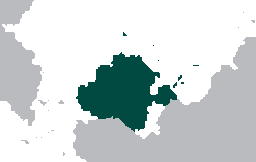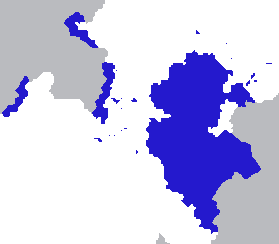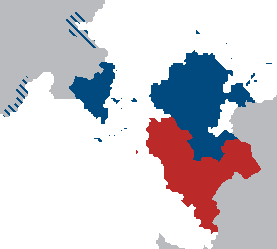Fugireu: Difference between revisions
No edit summary |
|||
| (29 intermediate revisions by 2 users not shown) | |||
| Line 1: | Line 1: | ||
{{Infobox country |
{{Infobox country |
||
|conventional_long_name = Kingdom of Fugireu <!--Formal or official full name of the country in English--> |
|conventional_long_name = Kingdom of Fugireu <!--Formal or official full name of the country in English--> |
||
| − | |native_name = |
+ | |native_name = {{cs|fug|wui´`ti`ra´`s fugi`reih}} <!--Country's name (usually full name) in its native language, hence in italics (double quotemarks)--> |
|common_name = Fugireu <!--Common name in English (used for wikilinks and to produce a default iso3166 code)--> |
|common_name = Fugireu <!--Common name in English (used for wikilinks and to produce a default iso3166 code)--> |
||
|image_flag = Flag-Fugireu.png <!--e.g. Flag of country.svg--> |
|image_flag = Flag-Fugireu.png <!--e.g. Flag of country.svg--> |
||
| Line 21: | Line 21: | ||
|alt_map2 = <!--alt text for second map--> |
|alt_map2 = <!--alt text for second map--> |
||
|map_caption2 = <!--Caption to place below second map--> |
|map_caption2 = <!--Caption to place below second map--> |
||
| − | |capital = |
+ | |capital = [[Zaxeebi]] <!--Name of country/territory's capital, wikilinked if link exists--> |
|latd= | latm= | latNS= |longd= |longm= |longEW= <!--capital's latitude and longitude in degrees/minutes/direction--> |
|latd= | latm= | latNS= |longd= |longm= |longEW= <!--capital's latitude and longitude in degrees/minutes/direction--> |
||
|largest_city = <!--Name of country/territory's largest city. Use "capital" (without quotemarks) if it's the capital.--> |
|largest_city = <!--Name of country/territory's largest city. Use "capital" (without quotemarks) if it's the capital.--> |
||
| Line 38: | Line 38: | ||
|ethnic_groups_year = <!--Year of ethnic groups data (if provided) or use to place a <ref>--> |
|ethnic_groups_year = <!--Year of ethnic groups data (if provided) or use to place a <ref>--> |
||
|demonym = [[Fuggic people|Fuggic]] <!--Term/s describing those associated with the country/territory (e.g. "Belgian" for the country Belgium)--> |
|demonym = [[Fuggic people|Fuggic]] <!--Term/s describing those associated with the country/territory (e.g. "Belgian" for the country Belgium)--> |
||
| − | |government_type = |
+ | |government_type = Unitary parliamentary constitutional monarchy <!--(often a compound multi-wikilinked term, e.g. "Federal semi-presidential constitutional republic", etc)--> |
|leader_title1 = King <!--(for a country, usually the head of state's (wikilinked) title, e.g. "President", "Monarch")--> |
|leader_title1 = King <!--(for a country, usually the head of state's (wikilinked) title, e.g. "President", "Monarch")--> |
||
|leader_name1 = [[Ozór III]] |
|leader_name1 = [[Ozór III]] |
||
| − | |leader_title2 = |
+ | |leader_title2 = Regulator <!--(could be "Vice President", otherwise "Prime Minster", etc, etc)--> |
| − | |leader_name2 = |
+ | |leader_name2 = [[Seérih Hríbór]] |
<!--......--> |
<!--......--> |
||
|leader_title6 = <!--(up to six distinct leaders may be included)--> |
|leader_title6 = <!--(up to six distinct leaders may be included)--> |
||
| Line 117: | Line 117: | ||
}} |
}} |
||
| − | Fugireu ([[Fuggic language|Fuggic]]: Wių́tįrą́s Fugįreuh) is a country located in Northwest Yazland. |
+ | Fugireu ([[Fuggic language|Fuggic]]: {{cs|fug|wui´`ti`ra´`s fugi`reih}} Wių́tįrą́s Fugįreuh) is a country located in Northwest Yazland bordering [[Hepetha]] and [[Teremres]]. |
| + | |||
==Etymology== |
==Etymology== |
||
| Line 123: | Line 124: | ||
===Yasgan migrations=== |
===Yasgan migrations=== |
||
| − | ===Osturic dynasty, 1521 CY – |
+ | ===Osturic dynasty, 1521 CY – 2013 CY=== |
| + | [[File:Osturic dynasty.png|thumb|left|The Osturic dynasty circa 1970 CY]] |
||
| + | The 16th century CY would see the rise of the first Fuggic state under the rule of the [[Osturic dynasty]]. The Osturic dynasty would rise under the rule of King [[Ostų́r the Builder|Fezorstóroh Ostų́r]] and would establish itself as the first organized kingdom in the area. Ostur would see the conquest of numerous Pre-Yasgan groups in Northern Fugireu, and would establish the traditional capital of [[Zaxeebi]]. The Osturic dynasty would become a vital trade connection between Etzavaz and Yazland in the [[Triangle Sea trade]], becoming vital trade partners of the Dhimze. The Osturic dynasty would see its last ruler with King [[Beugeeturuh Seéri]], who would lose the Battle of X in 2013 CY, and would see the country conquered by the [[Khozathian Empire]]. |
||
| + | |||
| + | ===Khozathian rule=== |
||
| + | |||
| + | ===Safiuric dynasty, 2117 CY – 2631 CY=== |
||
| + | [[File:Safiuric dynasty.png|thumb|right|The Safiuric dynasty circa ? CY]] |
||
| + | Following the success of [[Safiur’s Rebellion]], the Kingdom of Fugireu would be reestablished under [[Sáfiur the Great|Baséturuh Sáfiur]]. The Safiuric dynasty would become a powerful military force in West Yazland, conquering much of the X peninsula and expanding into modern day Hepetha. The Safiuric dynasty would come into conflict with the native pre-Yasgan peoples of Hepetha, and would end up nearly eradicating them following the brutal X war. The Safiuric dynasty would also begin the process of Fuggic colonization along the southeastern coast of [[Etzavaz]], frequently coming into conflict with the native Etzavazi peoples and establishing trade cities along the coast. |
||
| + | |||
| + | ===Two kingdoms period=== |
||
| + | [[File:Two Kingdoms Period.png|thumb|left|The initial division between Fugireu and Hepetha in 2631 CY]] |
||
| + | Following the death of King [[King Ką́zoma|Euyezęh Ką́zoma]], the Safiuric dynasty would be split into two kingdoms. Ką́zoma intended this as a compromise between his two sons, and hoped it would prevent a future civil war over the kingdom. [[Gęleyu the Immortal|Ką́zomah Gį́ríyo]] would become king of [[Kingdom of Hepetha|Hepetha]] while [[Nixigį́ I|Ką́zomah Nixigį́]] would continue to rule in Fugireu, becoming the Nixigic dynasty. In addition, Fuggic control over the various Etzavazi colonies would begin to wane, as various colonial settlements began to make their own independent decisions outside the monarchy's influence. The peace Ką́zoma had hoped to create would not last, as the two brothers, having grown separated over the years, came to blows multiple times over the independence of Hepetha. The Two Kingdoms period would end following the death of Nixigį́ I in battle against Gį́ríyo, after which the independence of Hepetha would be secured, and Gį́ríyo would abdicate in favor of his heir. |
||
| + | |||
| + | ===Giriyic dynasty 2636 CY – 2773 CY=== |
||
| + | Gį́ríyoh Dézeér would succeed Gį́ríyo as king of a largely united Fuggic mainland, however, remnants of the Nixigic dynasty would persist in Fuggic settlements across southern Etzavaz. Takuruh Zį́dǫ́, one of Nixigį́’s most trusted advisors, would be posthumously adopted by the dead king, continuing the Nixigic dynasty. |
||
| + | |||
| + | ===Wonuric dynasty, 2773 CY – 3287 CY=== |
||
| + | |||
| + | ===Kuhoric dynasty, 3288 CY – 3539 CY=== |
||
| + | |||
| + | ===Fuggic Civil War, 3540 CY – 3552 CY=== |
||
===Copper War=== |
===Copper War=== |
||
Latest revision as of 10:17, 6 December 2023
Kingdom of Fugireu wui´`ti`ra´`s fugi`reih | |
|---|---|
|
Flag | |
| Capital | Zaxeebi |
| Official languages | Fuggic |
| Demonym(s) | Fuggic |
| Government | Unitary parliamentary constitutional monarchy |
• King | Ozór III |
• Regulator | Seérih Hríbór |
Fugireu (Fuggic: wui´`ti`ra´`s fugi`reih Wių́tįrą́s Fugįreuh) is a country located in Northwest Yazland bordering Hepetha and Teremres.
Etymology
History
Yasgan migrations
Osturic dynasty, 1521 CY – 2013 CY

The 16th century CY would see the rise of the first Fuggic state under the rule of the Osturic dynasty. The Osturic dynasty would rise under the rule of King Fezorstóroh Ostų́r and would establish itself as the first organized kingdom in the area. Ostur would see the conquest of numerous Pre-Yasgan groups in Northern Fugireu, and would establish the traditional capital of Zaxeebi. The Osturic dynasty would become a vital trade connection between Etzavaz and Yazland in the Triangle Sea trade, becoming vital trade partners of the Dhimze. The Osturic dynasty would see its last ruler with King Beugeeturuh Seéri, who would lose the Battle of X in 2013 CY, and would see the country conquered by the Khozathian Empire.
Khozathian rule
Safiuric dynasty, 2117 CY – 2631 CY

Following the success of Safiur’s Rebellion, the Kingdom of Fugireu would be reestablished under Baséturuh Sáfiur. The Safiuric dynasty would become a powerful military force in West Yazland, conquering much of the X peninsula and expanding into modern day Hepetha. The Safiuric dynasty would come into conflict with the native pre-Yasgan peoples of Hepetha, and would end up nearly eradicating them following the brutal X war. The Safiuric dynasty would also begin the process of Fuggic colonization along the southeastern coast of Etzavaz, frequently coming into conflict with the native Etzavazi peoples and establishing trade cities along the coast.
Two kingdoms period

Following the death of King Euyezęh Ką́zoma, the Safiuric dynasty would be split into two kingdoms. Ką́zoma intended this as a compromise between his two sons, and hoped it would prevent a future civil war over the kingdom. Ką́zomah Gį́ríyo would become king of Hepetha while Ką́zomah Nixigį́ would continue to rule in Fugireu, becoming the Nixigic dynasty. In addition, Fuggic control over the various Etzavazi colonies would begin to wane, as various colonial settlements began to make their own independent decisions outside the monarchy's influence. The peace Ką́zoma had hoped to create would not last, as the two brothers, having grown separated over the years, came to blows multiple times over the independence of Hepetha. The Two Kingdoms period would end following the death of Nixigį́ I in battle against Gį́ríyo, after which the independence of Hepetha would be secured, and Gį́ríyo would abdicate in favor of his heir.
Giriyic dynasty 2636 CY – 2773 CY
Gį́ríyoh Dézeér would succeed Gį́ríyo as king of a largely united Fuggic mainland, however, remnants of the Nixigic dynasty would persist in Fuggic settlements across southern Etzavaz. Takuruh Zį́dǫ́, one of Nixigį́’s most trusted advisors, would be posthumously adopted by the dead king, continuing the Nixigic dynasty.
